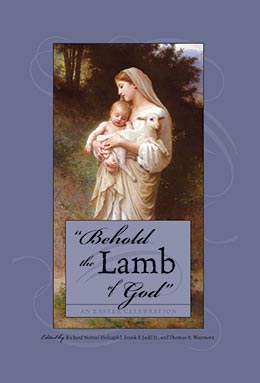Picturing the Resurrection
Herman du Toit
Herman du Toit, “Picturing the Resurrection,” in Behold the Lamb of God: An Easter Celebration, ed. Richard Neitzel Holzapfel, Frank F. Judd Jr., and Thomas A. Wayment (Provo, UT: Religious Studies Center, Brigham Young University, 2008), 185–200.
Herman du Toit was the head of museum research at the Museum of Art at Brigham Young University when this was published.
The power of images cannot be underestimated. Inspired works of art speak to us across the centuries, across cultures, and across national boundaries. This is because inspired art has the power to visualize and articulate the spiritual. One of the ways the artist serves us, the viewer, is to offer an interpretation or a personal vision of a particular event, and this in turn compels us to consider and reevaluate our own ideas and concepts. We may or may not agree with a particular representation, but the very act of looking causes us to test our own interpretations and preconceived ideas. More important, however, as we are drawn into the artist’s vision of a religious event, we come to realize for ourselves the truth behind what they are depicting. In this process of discovery, concepts are clarified, new meanings are instilled, and understanding is enlarged. Often much can be gleaned from a comparison of different artists’ works on the same subject. The following selection of artists’ works provides an opportunity for powerful insights into the seminal events that took place immediately following Christ’s Crucifixion.
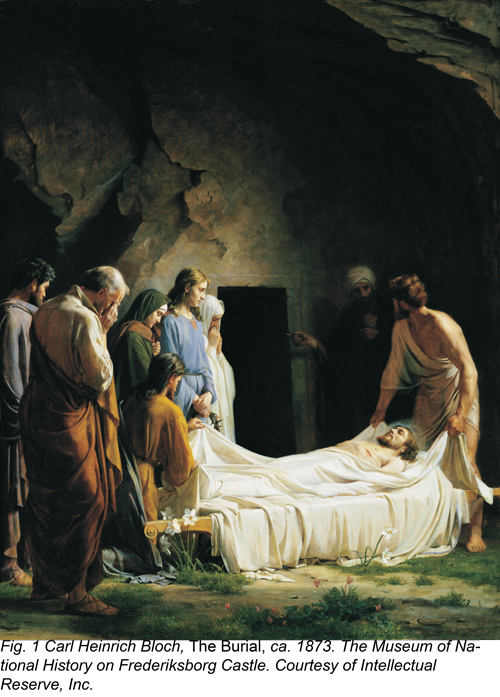
Carl Heinrich Bloch, a nineteenth-century Danish painter, in his work titled The Burial, depicts the moment that the Lord’s limp body is about to be lifted into the sepulchre (fig. 1). On the right we see Joseph of Arimathea gesturing into the dark recesses of the tomb as the small group of grief-stricken onlookers bows their heads in mute acknowledgment of the tragic, unforeseen, and horrible events which took place that afternoon. After witnessing the hurried burial in the sepulchre, we turn to a touching depiction by the nineteenth-century British painter William Dyce. In his painting John Leading Home His Adopted Mother (fig. 2), we see the Apostle John leading away his newly adopted mother, Mary, in accordance with the Lord’s final commission for his watch-care over her. He tenderly holds Mary’s arm. She appears deadly pale and leans on John for support. In the far distance to the left, we see three bare wooden crosses, indicating that their victims had been removed. To the right we can just make out a cavelike opening in the hill with two figures reclining nearby. Perhaps these are the soldiers who had been sent to guard the tomb.
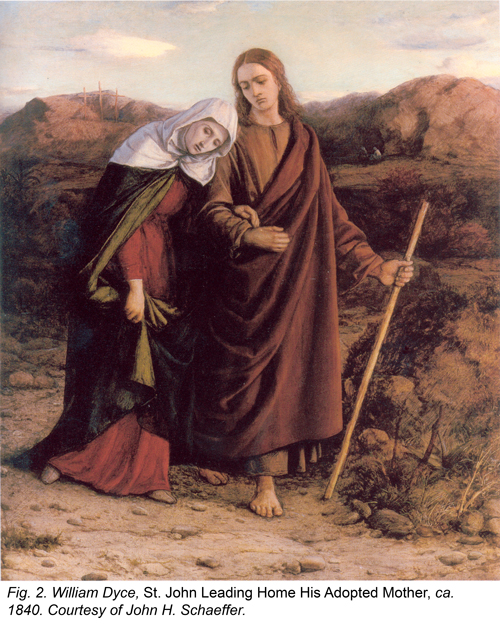
While divested of His body, between death on the cross and His Resurrection, Christ ministered among the departed spirits. Medieval painters often represented this event, known as Anastasias, as Christ rescuing souls from the grasp of Satan in Hades. Christ in Limbo, a sixteenth-century engraving by Albrecht Dürer, portrays a portion of hell’s gate broken asunder in the foreground (fig. 3). Christ kneels to lift a departed soul out of the grasp of the demons that appear menacingly from the orifices above the open portal.

The Resurrection, by Carl Bloch (fig. 4), captures the moment of Christ’s emergence from the sepulchre. The advent of the Lord’s Resurrection is presented in a powerful symmetrical composition with His head at the apex of an equilateral triangle. He looks heavenward, His arms raised in a dignified gesture of acknowledgment, gratitude, and affirmation. The resurrected Lord is flanked by two angels on bended knee who look up to Him with worshipful praise. Also appearing from the entrance of the tomb is a resplendent spray of lilies—the symbol of chastity, virtue, purity, and, particularly at Easter, new life.
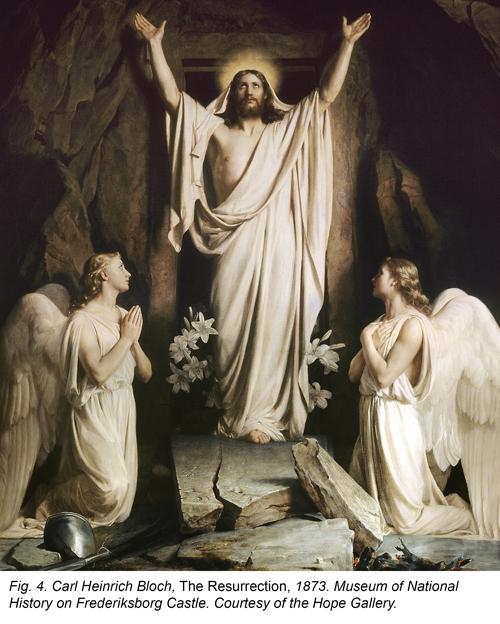
We read in the scriptures that on the first day of the week, at the first sign of dawn, the devoted Mary Magdalene came with other women to the tomb. After asking, “Who shall roll us away the stone from the door of the sepulchre?” (Mark 16:3), they were amazed to find that the stone had already been rolled away. An attendant angel then addressed them directly and succinctly, first dispelling their fear and then announcing for the first time the Lord’s Resurrection from the dead. After inviting them to witness the empty tomb, the angel instructed them to go quickly and tell the disciples that Christ had risen from the dead, as He said He would. This poignant encounter is depicted by the nineteenth-century French painter William Aldophe Bouguereau in his painting The Three Marys at the Tomb (fig. 5).

The grief stricken Mary Magdalene fails to comprehend the awesome and glorious message of the angel, only registering that her Lord’s body had been removed. We feel her anguish as she woefully declares, “They have taken away the Lord out of the sepulchre, and we know not where they have laid him” (John 20:2). After her report to the disciples, Peter and John run toward the sepulchre, an event wonderfully depicted by the nineteenth-century French painter Eugene Burnand. In his work, The Disciples Running to the Sepulchre, the highly animated John and Peter run side by side through the chill morning air toward the now vacant tomb (fig. 6). We note the anxious anticipation in their faces. It is only when they witness the empty tomb and encounter the angels that John records that they, for the first time, believed in the scripture that Christ would rise from the dead (see John 20:8–9).
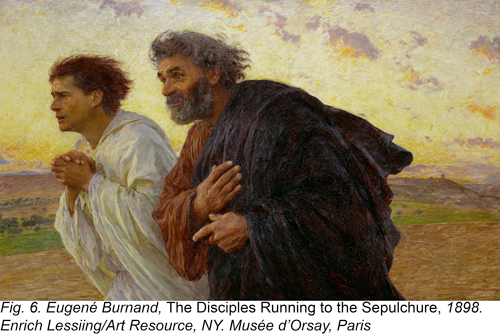
Meanwhile, the sorrowing and confused Mary Magdalene had followed the running disciples back to the tomb, and it is here that she becomes the first mortal to encounter the risen Savior face to face. In an act that Elder James E. Talmage refers to as “reverent love,”[1] Mary stretches out her arms to embrace her Lord, but He is quick to counter, “Touch me not; for I have not yet ascended to my Father” (John 20:17). This encounter has been depicted by artists throughout the history of Christian art. In the work Touch Me Not, by the sixteenth-century Italian artist Antonio Correggio (painted in the mannerist style of the late Renaissance), we note the careful choreography of the figures. These figures resonate with the artist’s newfound technical virtuosity in depicting the life of the human form with vitality and conviction (fig. 7). Another version of the same event, painted by the late-nineteenth-century Russian artist Alexander Ivanoff, depicts the scripture in a late neoclassical style that exemplifies the pristine qualities of classical Greek sculpture. We note the contraposto stance of the figure of Christ and the diaphanous drapery of His white robe, characteristic of the style of this neoclassical period (fig. 8).
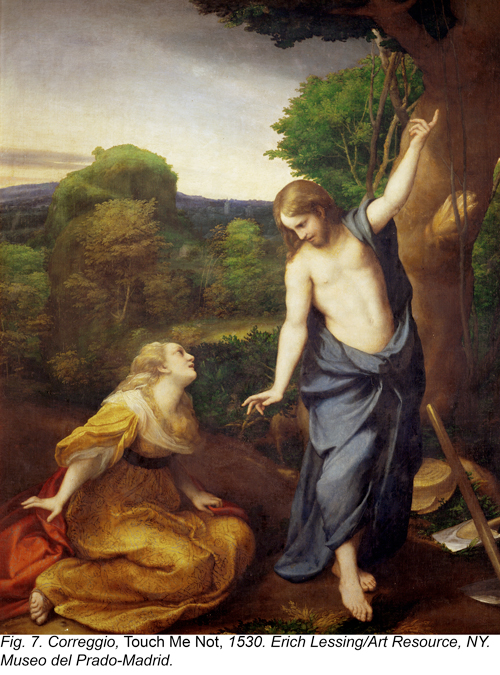
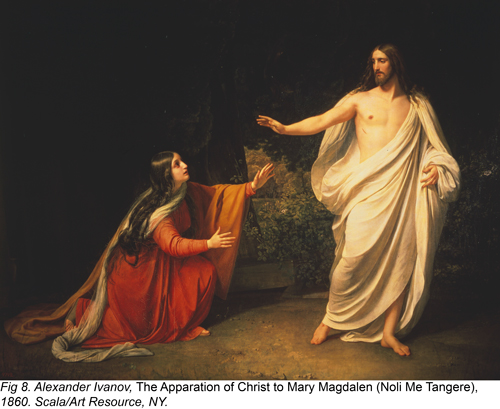
During the afternoon of the Resurrection day two disciples unwittingly encountered Christ as they walked to Emmaus, a small village about seven miles from Jerusalem. They were so engaged in conversation with this unrecognized stranger that they invited Him to share their dinner that evening at their destination. It was only while they were seated at the dinner table that their eyes were opened. We read, “They knew him; and he vanished out of their sight” (Luke 24:31). In the painting Supper at Emmaus, by the Italian painter Caravaggio, we see a beardless Christ at the dinner table with the disciples (fig. 9). Carravagio has emphasized the resplendent colors in the diners’ costumes. He has also lavished attention on the food on the table, treating the table setting as a sumptuous still life.
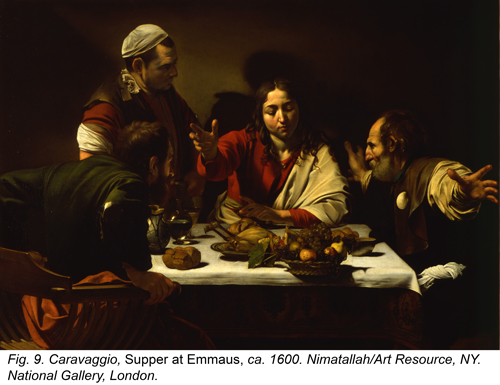
About eighty years later, the Dutch master Rembrandt painted his version of the supper at Emmaus (fig. 10). In his painting, the table is conspicuously bare and appears almost altarlike. Rembrandt bathes the quiet serenity of this humble scene in numinous light that appears to emanate from the seated figure of Christ. In Rembrandt’s depiction, Christ truly becomes the subject of the painting in a quiet and unassuming manner. The artist captures the supernal moment of engagement between this small group of mortals with their risen Lord as they converse with Him around the table.
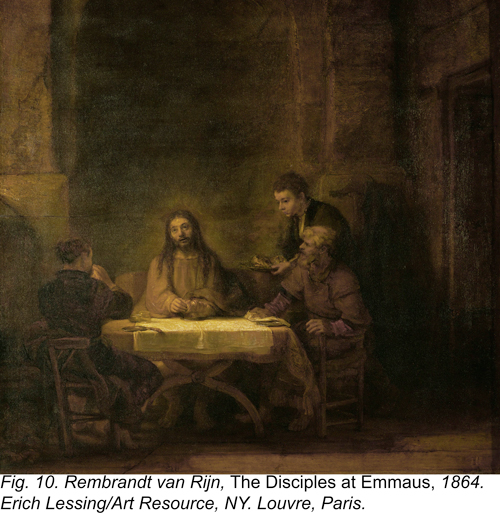
We can learn much from comparing the ways that artists visualize the same events. Carravagio’s depiction of Thomas thrusting his finger into the Savior’s side to confirm the veracity of His Resurrection can be contrasted with Carl Bloch’s depiction of the same event (figs. 11, 12). Bloch has depicted a more reserved and dignified Christ. There is no visceral contact between Thomas and the Savior. Instead we recognize Thomas’s conversion as he gazes down in awe at the Lord’s wounded feet and knows with a surety for the first time of Christ’s divinity and that he is in the presence of his Savior.
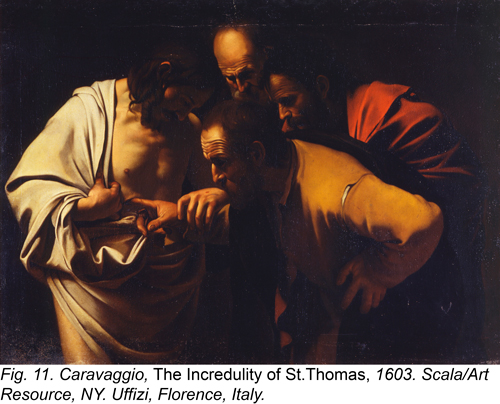
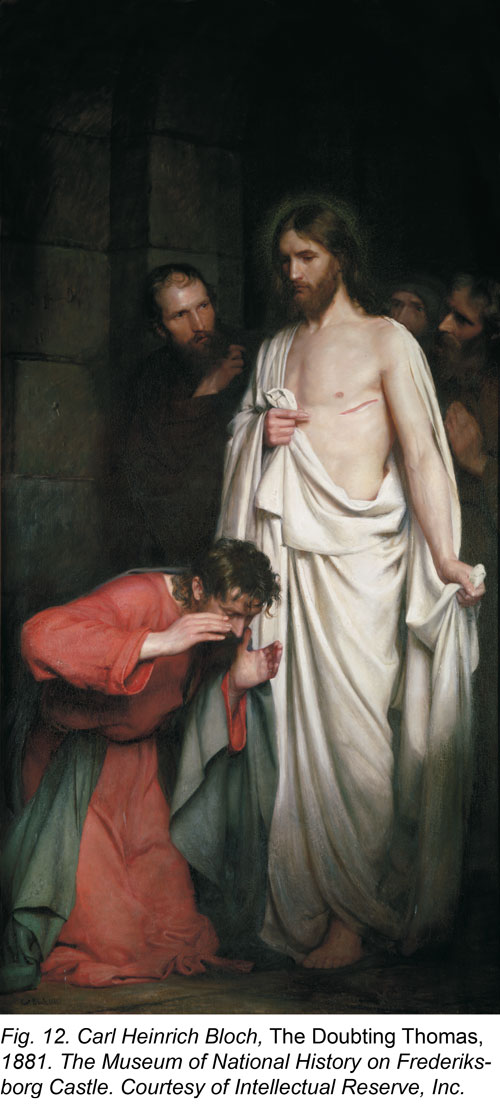
The Lord’s postmortal ministry to the Americas is depicted in a painting by Minerva Teichert, a twentieth-century Latter-day Saint artist, titled The Sacrament (fig. 13). Here we see the risen Lord instituting the sacrament in the New World. This is perhaps an understated rendering of the event by a refreshingly sensitive and sincere artist. The incontrovertible evidence of the risen Savior in our day is also depicted by Minerva Teichert in her painting of Christ and Heavenly Father’s appearance to the young Joseph Smith in her well-known and well-loved work, The First Vision (fig. 14).
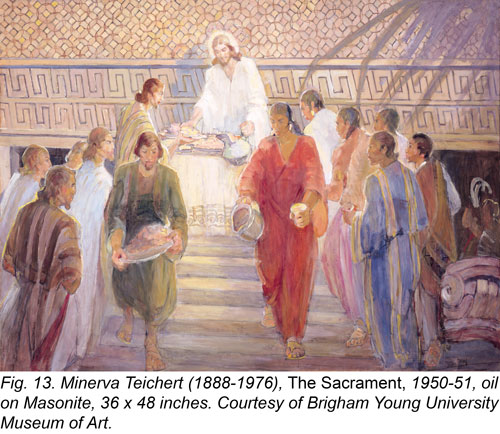
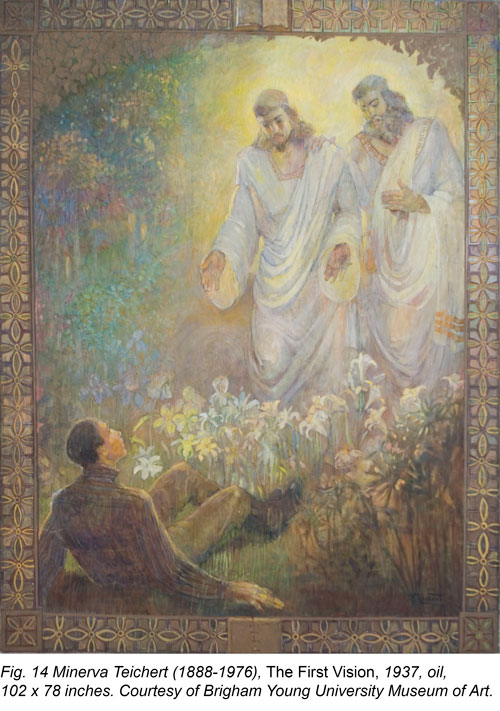
Inspired works of art have the power to edify and instruct to the extent that we approach them with an attitude of reverence and humility. Elder M. Russell Ballard stated, “Inspired art speaks in the language of eternity, teaching things to the heart that the eyes and ears can never understand.”[2] We can be edified and informed by thoughtful appreciation of the finest art by inspired artists throughout the Christian era. However, the image cannot work on its own; we need to be submissive to what the artwork stands for in order to truly view a devotional work of art—a poignant reminder that things of the Spirit are best understood with the Spirit, and it is only when we seek the Spirit that we can more faithfully apprehend, or picture, the Resurrection.
Notes
[1] James E. Talmage, Jesus the Christ (Salt Lake City: Deseret News, 1983), 632.
[2] M. Russell Ballard, “Filling the World with Goodness and Truth,” Ensign, July 1996, 10.
